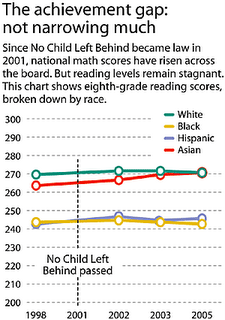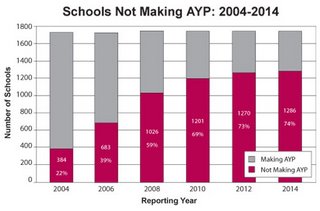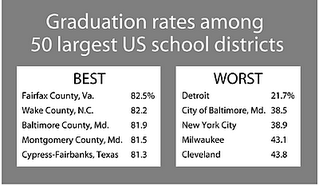 (Chart at left from The Christian Science Monitor)
(Chart at left from The Christian Science Monitor)It's going to be another big week for the Decider. Not only will he be going before a hostile public to advocate for an escalation of his War, but he will meet with Miller and Kennedy this morning to charm his way toward a new surge in the continued war on the poor and on the public education system in our country. It comes just in time to mark the five-year anniversary of the most reckless, destructive and utterly failed education policy ever. Let's take a little accounting of how NCLB is accomplishing its goals as set out in 2002:
Performance Goal 1: By 2013-2014, all students will reach high standards, at a minimum attaining proficiency or better in reading/language arts and mathematics.
Reality 1: The most significant form of educational growth is the alarming increases in the number of schools not making AYP (adequate yearly progress) toward the impossible goal of 100% proficiency. In Massachusetts and Connecticut, for instance, where public schools are the strongest, the NCLB-mandated failure in reaching beyond the impoverished urban schools and into suburban enclaves.
 Here is a chart from a study commissioned in Massachusetts (click to enlarge) that shows 74% of their schools failing to make AYP by 2014. If ED has its way, of course, these schools will have been turned in corporate welfare charter schools by then.
Here is a chart from a study commissioned in Massachusetts (click to enlarge) that shows 74% of their schools failing to make AYP by 2014. If ED has its way, of course, these schools will have been turned in corporate welfare charter schools by then.
Performance Goal 2: All limited English proficient students will become proficient in English and reach high academic standards, at a minimum attaining proficiency or better in reading/language arts and mathematics.
Reality 2: If most people know that 100% proficiency is impossible for native speakers, 100% of people know that English-language learners and special ed. students are not going to become 100% proficient. The insanity of this goal clearly demonstrates the built-in failure that will not, cannot, be overcome, regardless of all the wishful thinking by the likes of Kati Haycock and Amy Wilkins at Ed Trust.
The attempted implementation of this goal has caused more grief and confusion and resignations than most could have imagined in 2001. On the one hand, higher standards would seem to guarantee more qualified teachers. This could have been the case if not for the overriding ideological commitment to bypass schools of education in creating a teacher corps is "highly-qualified."
 ED prefers teachers who have passed subject matter tests to teachers who have completed professional certification programs. In the meantime, states like New Jersey now have a 52-page document explaining what it means to be "highly-qualified." Or check out the NEA's guide to highly-qualified (Download this chart as a PDF document here).
ED prefers teachers who have passed subject matter tests to teachers who have completed professional certification programs. In the meantime, states like New Jersey now have a 52-page document explaining what it means to be "highly-qualified." Or check out the NEA's guide to highly-qualified (Download this chart as a PDF document here).Performance Goal 4: All students will be educated in learning environments that are safe, drug-free, and conducive to learning.
Reality 4: 14 percent of eighth graders, 28 percent of 10th graders, and 36 percent of 12th graders used an illicit substance during the past year.
In terms of safety, here are the key findings from the latest (2004) School Safety Survey conducted by the National Association of School Resource Officers (NASRO):
More than 55% of the school officers stated that teachers, administrators, and support staff (secretaries, custodians, etc.) do not receive ongoing professional development training on school security and emergency preparedness issues.
Over 65% of the SROs stated that school bus drivers and other school transportation personnel have not received training during the past three years on issues related to security measures, emergency planning and response, terrorism, and associated topics.
Nearly 86% of respondents indicated that the number of crimes that occur on school campuses nationwide are underreported to law enforcement.The majority of SROs (over 54%) stated that the federal “No Child Left Behind” law requiring states to create definitions of “persistently dangerous” schools decreases school crime reporting. Only 17% believed the law would improve school crime reporting.
The majority of school-based police officers (67%) believe that a federal law mandating the reporting of serious/violent school crimes to law enforcement would enhance law enforcement efforts to reduce school crime. Over 20% were uncertain as to whether such a law would improve school crime reporting.
Over 70% of the surveyed school officers indicated that funding for school safety in their districts is either decreasing or remaining the same.
Only 15% of respondents reported an increase in safe schools funding.
Over 70% of the survey respondents reported that school safety funding either decreased or remained the same in their district. Over 25% of that figure said that school safety funding was decreasing in their district, while over 44% said that funding was remaining the same. Only slightly more than 15% reported an increase in school safety funding in their districts.
More than 80% of the SROs believe that, considering the amount of federal funding being provided to improve homeland security for non-school entities, the amount of funding being made available specifically for K-12 school security and emergency preparedness planning is not enough.
Performance Goal 5: All students will graduate from high school.
 In June 2006 the Christian Science Monitor reported on a new study funded by the Gates Foundation that showed a dropout epidemic in American high schools. The Administration's solution: increased testing in high school.
In June 2006 the Christian Science Monitor reported on a new study funded by the Gates Foundation that showed a dropout epidemic in American high schools. The Administration's solution: increased testing in high school.In the meantime, high schools have survived repeated attempts by the Administration to eviscerate vocational education, proposing in 2006 to simply eliminate all vocational education programs. The Administration is pushing, too, for more testing in high schools under the perverse rationale that testing will improve high schools and improve dropout rates, when the evidence points to the contrary. The 10 states, in fact, with the lowest graduation rates all have high school exit exams, and 9 of them have had exit exams for more than 10 years:
Georgia (1994)
Nevada (1981)
Florida (1979)
Arizona (2006)
Tennessee (1986)
S. Carolina (1990)
Mississippi (1989)
Alabama (1985)
North Carolina (1982)
New Mexico (1990)
No comments:
Post a Comment